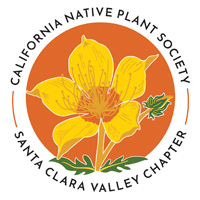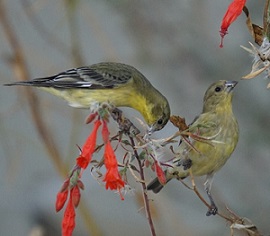Books for the Native Plant Gardener
Many of the books listed here are available for purchase during Chapter plant sales and events.
Fundamental BooksWe think these are books that every native plant gardener should have. Some are available in libraries, and available for purchase during our Chapter plant sales and events. |
||
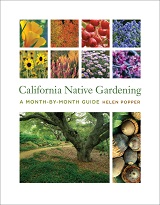 |
CALIFORNIA NATIVE GARDENING, A MONTH-BY-MONTH GUIDE. Helen Popper. University of California Press (2012). 217 pp, paperback. Helen Popper is a long-time member of the Santa Clara Valley chapter of the California Native Plant Society and was one of the first members of the chapter's Gardening with Natives group. She was the note taker at the group's early monthly meetings, and this book is a compilation of the knowledge of the group's members from those meetings. It provides a useful roadmap of the tasks that need to be covered each month to create and maintain a native plant garden. Popper has given talks about these concepts for our chapter. You can view one of them here. |
|
 |
CALIFORNIA NATIVE PLANTS FOR THE GARDEN. Carol Bornstein, David Fross, Bart O'Brien. Cachuma Press (December 1, 2005). 280 pp, paperback & hardback. This comprehensive resource features more than 500 of the best California native plants for gardening. Written by three of the state's leading native-plant horticulturists and illustrated with 450 color photos, this reference book also includes chapters on landscape design, installation, and maintenance. Detailed lists of recommended native plants for a variety of situations and appendices with information on places to see native plants and where to buy them are also provided. | |
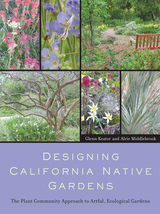 |
DESIGNING CALIFORNIA NATIVE PLANTS GARDENS: THE PLANT COMMUNITY APPROACH TO ARTFUL, ECOLOGICAL GARDENS. Glenn Keator and Alrie Middlebrook. University of California Press (June 4, 2007). 352 pp, paperback. This book was created with the aim of conveying the awesome diversity and beauty of California's native plants and demonstrating how they can be brought into ecologically sound, attractive, workable, and artful gardens. Structured around major California plant communities--bluffs, redwoods, the Channel Islands, coastal scrub, grasslands, deserts, oak woodlands, mixed evergreen woodlands, riparian, chaparral, mountain meadows, and wetlands--the book's twelve chapters each include sample plans for a native garden design accompanied by original drawings, color photographs, a plant list, tips on successful gardening with individual species, and more. | |
Useful References
|
||
 |
GARDENING WITH A WILD HEART. Judith Larner Lowry. University of California Press (1999), Berkeley, CA. 252 pp, softback. A compelling investigation into the whys and hows of gardening with native plants. Its engaging style mixes personal history, botany, anthropology, and ecology, and brings it all to bear on what you could be doing in your yard. This book has inspired many to practice restoration gardening. | |
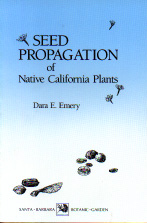 |
SEED PROPAGATION OF NATIVE CALIFORNIA PLANTS. Dara Emery. Santa Barbara Botanic Garden, Santa Barbara, CA. 115 pp, softback. An extensive table lists germination and propagation requirements of hundreds of native species. | |
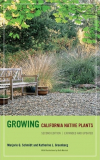 |
Growing California Native Plants, Second Edition. Marjorie G. Schmidt (Author), Katherine Greenberg (Author), Beth Merrick (Illustrator). University of California Press, Berkeley, CA. 296 pages, softback. March 26, 2012. This book is still at the top of the heap when it comes to books on native plant gardening. Written for the gardener, the book covers a wide variety of native plants, their characteristics, culture information, and estimate of garden value. This is a must-have book for beginners and experts alike. | |
 |
COMPATIBLE PLANTS UNDER AND AROUND OAKS. Bruce Hagen et al. California Oak Foundation, 1212 Broadway, Suite 810, Oakland, CA 94612. 69 pp, softback. Out of print, but available as a free download. | |
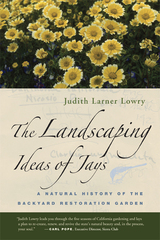 |
THE LANDSCAPING IDEAS OF JAYS: A NATURAL HISTORY OF THE BACKYARD RESTORATION GARDEN. Judith Larner Lowry. University of California Press, 2007. 292 pp, softback. Elegantly organized by season, this lyrical yet practical guide to backyard restoration gardening celebrates the beauty, the challenges, and the rewards of growing native plants at home. Drawing on her experiences in her own garden, Lowry offers guidance on how to plan a garden with birds, plants, and insects in mind; how to shape it with trees and shrubs, paths and trails, ponds, and other features; and how to cultivate, maintain, and harvest seeds and food from a diverse array of native annuals and perennials. Lowry shares the delights of creating site-specific, ever-changing gardens that can help us better understand our place in the natural world. | |
 |
THE CALIFORNIA LANDSCAPE GARDEN: ECOLOGY, CULTURE, AND DESIGN. Mark Francis, Andreas Reimann. University of California Press. 1999. 254 pp, hardcover. The beauty, resources, and natural processes of the California landscape are brought to the home garden in Mark Francis and Andreas Reimann's fine testament to ecological gardening. The authors connect history, culture, region, and design to help us understand how California and its human population have evolved historically and how individuals today can make a difference in the state's future in their own backyards. They provide essential information on native plants and wildlife, ecology and bioregionalism, landscape history and design concepts, as well as numerous examples showing how to integrate environmental principles in one's garden. This is a book for anyone seeking a garden philosophy that is environmentally sensitive, and even experienced home gardeners, landscape professionals, and horticulturists will find new and useful material here. | |
CLASSIC REFERENCES
|
||
 |
FLOWERING SHRUBS OF CALIFORNIA AND THEIR VALUE TO THE GARDENER. Lester Rowntree. Stanford University Press. 1939. One of the earliest and best written books on native plants. Worth looking for in used book stores. | |
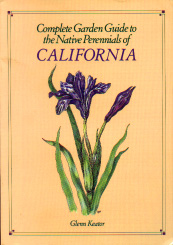 |
NATIVE PERENNIALS OF CALIFORNIA. Glenn Keator. Chronicle Books, San Francisco, CA. 303 pp, softback. This out-of-print book is worth hunting for in used bookstores for its encyclopedic content. | |
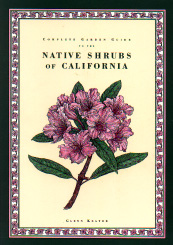 |
NATIVE SHRUBS OF CALIFORNIA. Glenn Keator. Chronicle Books, San Francisco, CA. 314 pp, softback. A handy reference on woody native plants. A particularly useful section is the appendix on commonly available cultivars. | |
|
||
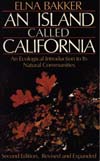 |
AN ISLAND CALLED CALIFORNIA. Elna Bakker. University of California Press. 400 pp, softback. A classic reference which connects the native flora, fauna, climate, and geography of each biotic community in the state. | |
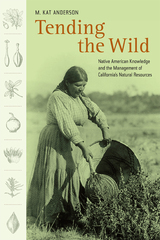 |
TENDING THE WILD: NATIVE AMERICAN KNOWLEDGE AND THE MANAGEMENT OF CALIFORNIA'S NATURAL RESOURCES. M. Kat Anderson. University of California Press, 2006. 555 pp, paperback. John Muir was an early proponent of a view we still hold today--that much of California was pristine, untouched wilderness before the arrival of Europeans. But as this groundbreaking book demonstrates, what Muir was really seeing when he admired the grand vistas of Yosemite and the gold and purple flowers carpeting the Central Valley were the fertile gardens of the Sierra Miwok and Valley Yokuts Indians, modified and made productive by centuries of harvesting, tilling, sowing, pruning, and burning. Marvelously detailed and beautifully written, Tending the Wild is an unparalleled examination of Native American knowledge and uses of California's natural resources that reshapes our understanding of native cultures and shows how we might begin to use their knowledge in our own conservation efforts. Tending the Wild persuasively argues that this traditional ecological knowledge is essential if we are to successfully meet the challenge of living sustainably. | |
